Index to Trees & Shrubs in the Order Arecales
Family: Arecaceae (Palm Family)
23. Hyphaene coriacea Southern Lala-palm, Ilala Palm https://africawild-forum.com/viewtopic.p ... 00#p175200
24. Hyphaene petersiana Northern Lala-palm https://africawild-forum.com/viewtopic.p ... 94#p175153
26. Raphia australis Rafia Palm, Kosi Palm, Giant Palm https://africawild-forum.com/viewtopic.p ... 94#p171723
Africa Wild Tree & Shrub Book - Order Arecales
Moderator: Klipspringer
Re: Africa Wild Tree & Shrub Book - Order Arecales
26. Rafia Palm, Kosi Palm, Giant Palm Raphia australis
Order: Arecales. Family: Arecaceae


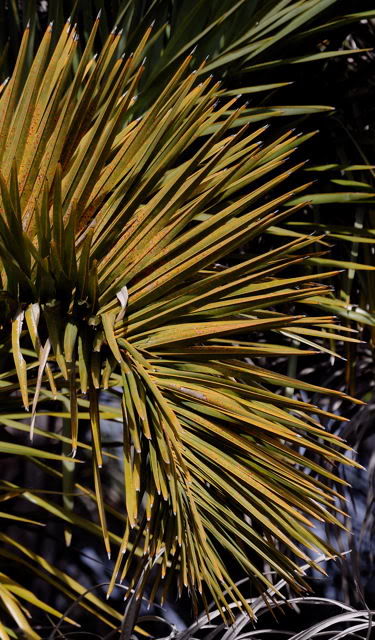
Kosi Forest Lodge, KwaZulu-Natal in July.
Description
It has the largest fronds of all palm species, growing up to 16 m in height, with a single trunk, and huge leaves growing from the tip of the trunk to form a V-shaped canopy. The once compund blue green leaves can be up to 18 m long. Huge flowerheads (up to 3m high) are produced after about 30 years. The tree dies after producing masses of large, oval fruit (90 mm long) that have only one seed, They take 2 years to mature, and are covered by red-brown, shiny scales.
Its fruits are an important part of the diet of the endangered Palm-nut Vulture Gypotherax angolensis and this bird's range is closely related to this tree. The Rafia Palm is found growing on dunes that are flooded seasonally and has a root structure that can "breathe" similar to that found in mangroves.
Distribution
This species is indigenous to Southern Africa having a range from a few kilometres South of Kosi Bay in KwaZulu-Natal to about 40 kilometres North of Maputo in Mozambique.
A large Kosi palm forest is located on the banks of the 4th Kosi lake called Amanzimyama.
Habitat
This palm occurs in swamp forest.
Links: PlantZAfrica
 © Duke
© Duke
Mtunzini Raphia Palm Monument, KwaZulu-Natal
Order: Arecales. Family: Arecaceae



Kosi Forest Lodge, KwaZulu-Natal in July.
Description
It has the largest fronds of all palm species, growing up to 16 m in height, with a single trunk, and huge leaves growing from the tip of the trunk to form a V-shaped canopy. The once compund blue green leaves can be up to 18 m long. Huge flowerheads (up to 3m high) are produced after about 30 years. The tree dies after producing masses of large, oval fruit (90 mm long) that have only one seed, They take 2 years to mature, and are covered by red-brown, shiny scales.
Its fruits are an important part of the diet of the endangered Palm-nut Vulture Gypotherax angolensis and this bird's range is closely related to this tree. The Rafia Palm is found growing on dunes that are flooded seasonally and has a root structure that can "breathe" similar to that found in mangroves.
Distribution
This species is indigenous to Southern Africa having a range from a few kilometres South of Kosi Bay in KwaZulu-Natal to about 40 kilometres North of Maputo in Mozambique.
A large Kosi palm forest is located on the banks of the 4th Kosi lake called Amanzimyama.
Habitat
This palm occurs in swamp forest.
Links: PlantZAfrica
 © Duke
© DukeMtunzini Raphia Palm Monument, KwaZulu-Natal
Dewi
What is the good of having a nice house without a decent planet to put it on? (H D Thoreau)
What is the good of having a nice house without a decent planet to put it on? (H D Thoreau)
Re: Africa Wild Tree & Shrub Book - Order Arecales
24. Northern Lala-palm, Real Fan Palm, Makalani-palm Hyphaene petersiana (Noordelike Lalapalm, Opregte Waaierpalm)
Order: Arecales. Family: Arecaceae
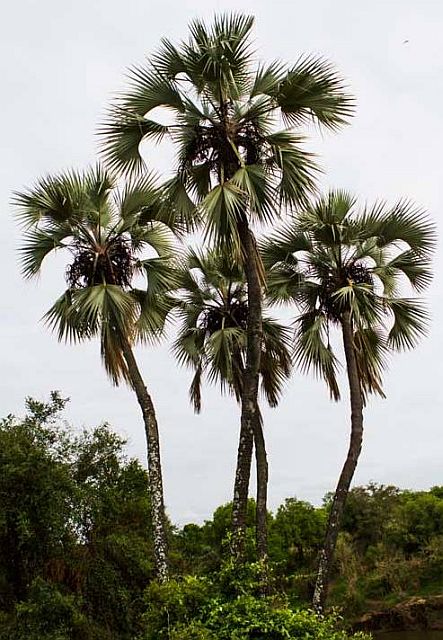 © Pumbaa
© Pumbaa
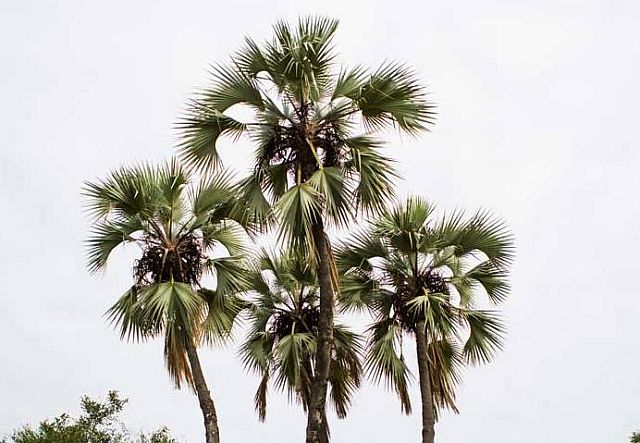 © Pumbaa
© Pumbaa
Kruger National Park, Shingwedzi
 © Toko
© Toko
Palmwag, northwest Damaraland, Namibia
Description
Tall erect, single-stemmed tree. Stems erect, rarely suckering to form clumps. Leaves crowded on top of the stem, fan-shaped, up to 2.5 m including the petiole. Petiole armed with recurved thorns. Male and female flowers on different trees; male flowers in short spikes; female flowers in large sprays, which develop into branched trusses of fruits. Fruits almost spherical, 4-6cm in diameter. The hard white kernel of the seed is known as "vegetable ivory". This species is very similar to the closely related H. coriacea and there is some debate about the exact taxonomic status of the two. H. coriacea differs mainly in the fruit being pear-shaped. The trees appear to be generally smaller and sucker more readily.
Distribution
From Central Africa to Namibia, Botswana, Zimbabwe and South Africa (Limpopo, Mpumalanga).
Habitat
In dry sandy areas, often away from rivers.
Links: Ernst Schmidt, Mervyn Lotter, Warren McCleland: Trees and Shrubs of Mpumalanga and Kruger National Park; Namibian Tree Atlas (PDF); SAPPI Tree Spotting - Lowveld
Order: Arecales. Family: Arecaceae
 © Pumbaa
© Pumbaa © Pumbaa
© PumbaaKruger National Park, Shingwedzi
 © Toko
© TokoPalmwag, northwest Damaraland, Namibia
Description
Tall erect, single-stemmed tree. Stems erect, rarely suckering to form clumps. Leaves crowded on top of the stem, fan-shaped, up to 2.5 m including the petiole. Petiole armed with recurved thorns. Male and female flowers on different trees; male flowers in short spikes; female flowers in large sprays, which develop into branched trusses of fruits. Fruits almost spherical, 4-6cm in diameter. The hard white kernel of the seed is known as "vegetable ivory". This species is very similar to the closely related H. coriacea and there is some debate about the exact taxonomic status of the two. H. coriacea differs mainly in the fruit being pear-shaped. The trees appear to be generally smaller and sucker more readily.
Distribution
From Central Africa to Namibia, Botswana, Zimbabwe and South Africa (Limpopo, Mpumalanga).
Habitat
In dry sandy areas, often away from rivers.
Links: Ernst Schmidt, Mervyn Lotter, Warren McCleland: Trees and Shrubs of Mpumalanga and Kruger National Park; Namibian Tree Atlas (PDF); SAPPI Tree Spotting - Lowveld
Re: Africa Wild Tree & Shrub Book - Order Arecales
23. Southern Lala-palm, Ilala palm Hyphaene coriacea (Palmboom, Waaierpalm)
Order: Arecales. Family: Arecaceae
 © Toko
© Toko
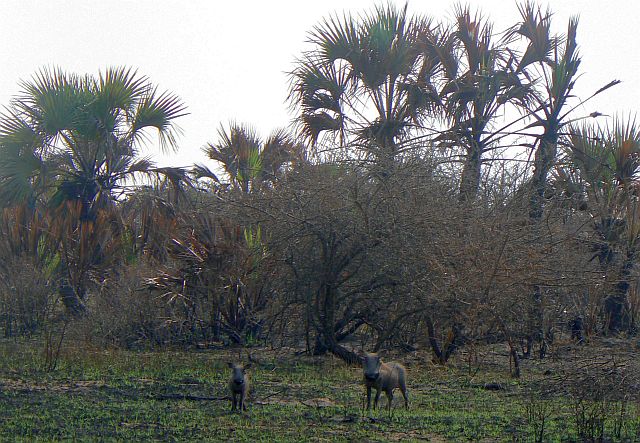 © Toko
© Toko
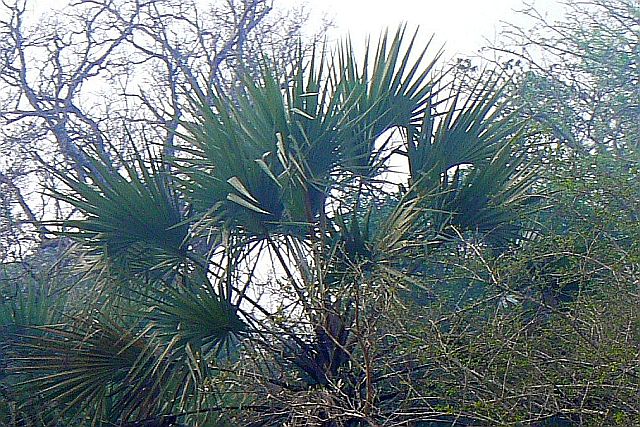 © Toko
© Toko
Tembe Elephant Park, KwaZulu-Natal
Description
Small ascending to prostrate palm up to 5 m tall. Trunks many, straight, with prominent, discontinuous, large leaf scars; unarmed. Stems often suckering to form clumps. Leaves crowded on top of the stem, fan-shaped, up to 2.5 m including the petiole. Petiole armed with recurved thorns. Leaves spirally arranged, costa-palmate (fan-like, with a midrib), blue-grey. Petiole margin with teeth ± 10 mm apart, 10 mm long, forward pointing. Leaflets 2-ranked, erect, evenly spaced, with the central fold down (induplicate), with one fold each, linear. Lamina up to 400 x 35 mm. Tips simple, acute, smooth, straight. Leaf bases persistent, scale-like, split, without an inner auricle, woody. There are hooked thorns on the leaf-stems.
Inflorescence between the leaves, branched, pendulous, 0.4-1.0 m long. Plants are dioecious (separate male and female trees). Male inflorescence slenderer and more branched than female. Male flowers in threes, in pits; sepals joined, stamens free, 6. Female flowers solitary, perianth like males; carpels united, styles free, stigmas almost sessile. Ovary and fruit smooth. Fruit distinctly pear-shaped, brown, stepped, fibrous, 30-60 x 15-40 mm.
This species is very similar to the closely related H. petersiana and there is some debate about the exact taxonomic status of the two. H. petersiana differs mainly in the fruit being spherical. The trees of that species appear to be non-suckering and generally taller, although in areas where the trees experience little damage from elephants or man tall erect specimens of H. coriacea are not uncommon.
Distribution
Provincial distribution in South Africa: KwaZulu-Natal, Limpopo, Mpumalanga (throughout the Lowveld and along the coastal strip of KwaZulu-Natal, into the Eastern Cape). They occur in Zimbabwe, Angola, Botswana, northern Transvaal and Namibia.
Habitat
Grassland or depressions in bushveld. Occurring near pans and floodplains but also away from rivers.
Links: Ernst Schmidt, Mervyn Lotter, Warren McCleland: Trees and Shrubs of Mpumalanga and Kruger National Park; Wild About Trees; SAPPI Tree Spotting - Lowveld
Order: Arecales. Family: Arecaceae
 © Toko
© Toko © Toko
© Toko © Toko
© TokoTembe Elephant Park, KwaZulu-Natal
Description
Small ascending to prostrate palm up to 5 m tall. Trunks many, straight, with prominent, discontinuous, large leaf scars; unarmed. Stems often suckering to form clumps. Leaves crowded on top of the stem, fan-shaped, up to 2.5 m including the petiole. Petiole armed with recurved thorns. Leaves spirally arranged, costa-palmate (fan-like, with a midrib), blue-grey. Petiole margin with teeth ± 10 mm apart, 10 mm long, forward pointing. Leaflets 2-ranked, erect, evenly spaced, with the central fold down (induplicate), with one fold each, linear. Lamina up to 400 x 35 mm. Tips simple, acute, smooth, straight. Leaf bases persistent, scale-like, split, without an inner auricle, woody. There are hooked thorns on the leaf-stems.
Inflorescence between the leaves, branched, pendulous, 0.4-1.0 m long. Plants are dioecious (separate male and female trees). Male inflorescence slenderer and more branched than female. Male flowers in threes, in pits; sepals joined, stamens free, 6. Female flowers solitary, perianth like males; carpels united, styles free, stigmas almost sessile. Ovary and fruit smooth. Fruit distinctly pear-shaped, brown, stepped, fibrous, 30-60 x 15-40 mm.
This species is very similar to the closely related H. petersiana and there is some debate about the exact taxonomic status of the two. H. petersiana differs mainly in the fruit being spherical. The trees of that species appear to be non-suckering and generally taller, although in areas where the trees experience little damage from elephants or man tall erect specimens of H. coriacea are not uncommon.
Distribution
Provincial distribution in South Africa: KwaZulu-Natal, Limpopo, Mpumalanga (throughout the Lowveld and along the coastal strip of KwaZulu-Natal, into the Eastern Cape). They occur in Zimbabwe, Angola, Botswana, northern Transvaal and Namibia.
Habitat
Grassland or depressions in bushveld. Occurring near pans and floodplains but also away from rivers.
Links: Ernst Schmidt, Mervyn Lotter, Warren McCleland: Trees and Shrubs of Mpumalanga and Kruger National Park; Wild About Trees; SAPPI Tree Spotting - Lowveld


